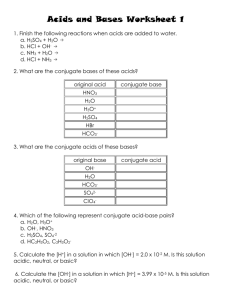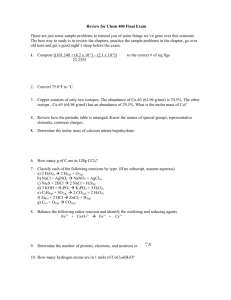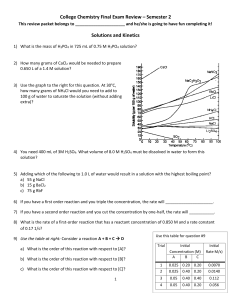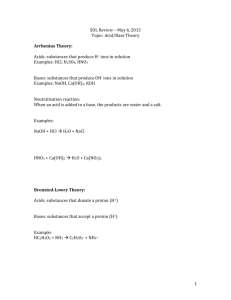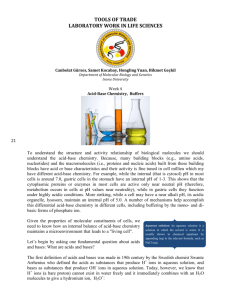pH calculations
advertisement
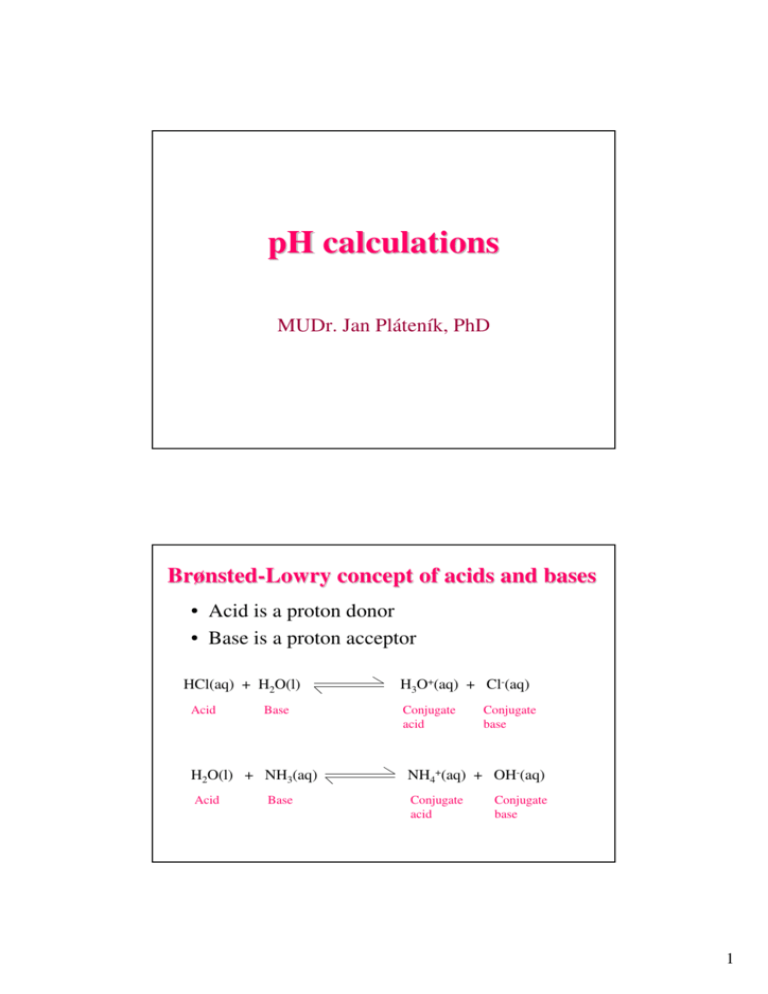
pH calculations MUDr. Jan Pláteník, PhD Brønsted-Lowry concept of acids and bases • Acid is a proton donor • Base is a proton acceptor HCl(aq) + H2O(l) Acid Base H3O+(aq) + Cl-(aq) Conjugate acid Conjugate base H2O(l) + NH3(aq) NH4+(aq) + OH-(aq) Acid Conjugate acid Base Conjugate base 1 Which of the following are conjugate acid-base pairs? A) HCl, NaOH B) H2O, OHC) H2SO4, SO42D) H2SO3, HSO3E) HClO4, ClO3F) H3C-NH2, H3C-NH3+ Autoionization of water Water is amphoteric as it can behave both as acid and base 2 H2O(l) H3O+(aq) + OH-(aq) Ion-product constant for water: Kw = [H3O+][OH-] = [H+][OH-] In pure water at 25 ºC: [H+] = [OH-] = 1.0 × 10-7 mol/L Kw = (1.0 × 10-7 mol/L)×( 1.0 × 10-7 mol/L) = 1.0 × 10-14 mol2/L2 Constant! 2 pH pH= -log10(activity of H+) pOH= -log10(activity of OH-) Ion-product of water (constant!): Activity = f . c f is activity coefficient, f<1, c is molar concentration pH + pOH = 14 E.g.: pH=7 (neutral): [H+] = 10-7 M = 0.0000001 mol/l pH=1 (acidic): [H+] = 10-1 M = 0.1 mol/l pH=13 (alkaline): [H+] = 10-13 M = 0.0000000000001 mol/l Strong acid E.g. HCl, HNO3, H2SO4 In aqueous solution fully dissociates to H+ and A− pH of strong acid can be calculated as pH = −log (f × [H+]) For HCl: [H+]= [HCl] For H2SO4: [H+]= 2 × [H2SO4] 3 Calculating the pH of strong acid solutions Example: Calculate the pH of 0.06 mol/L HCl. pH = − log0.06 = 1.22 Calculating the pH of strong acid solutions Example 2: Calculate the pH of 0.02 mol/L H2SO4. pH = − log0.04 = 1.3979 = ~ 1.4 4 Calculating the pH of strong acid solutions Example 3: Calculate the pH of 1.0 × 10-10 M HCl. pH = − log(10-10) = 9 …. alkaline? Water contributes more protons than HCl in this case (10-7 M), pH will be the same as in pure water, i.e. 7 Strong base E.g. NaOH, KOH, Ba(OH)2 In aqueous solution fully dissociate to metal ion and OH− pH of strong base can be calculated as pOH = −log (f × [OH-]) pH = 14 − pOH = 14 −(−log (f × [OH-]) For NaOH: [OH-]= [NaOH] For Ba(OH)2: [OH-]= 2 × [Ba(OH)2] 5 Calculating the pH of strong base solutions Example: a) Calculate the pH of NaOH 0.5 mol/L. pH = 14−(−log0.5) = ~13.7 b) If this solution is diluted 10-fold, what will be the resulting pH? pH = ~12.7 Weak acid E.g. H2CO3, CH3COOH Only some small fraction of molecules in solution dissociates to anion and proton: CH3COOH ↔ CH3COO− + H+ [CH3COO−] × [H+] Kd = [CH3COOH] pH = ½ × pK – ½ × log [AH] pK = −log Kd 6 • If we know pK (Kd) and concentration of a weak acid solution, we can calculate (predict) pH of the solution: pH = ½ × pK – ½ × log [AH] • If we measure pH of a weak acid solution of a known concentration, we can determine its pK (Kd): pK = 2 × pH + log [AH] Reading pK of weak acid from titration curve Inflection point: If weak acid is just half-titrated, then pH = pK [CH3COO−] . [H+] Kd = [CH3COOH] 7 Calculating the pH of weak acid solutions Example: Calculate the pH of 0.01 mol/L acetic acid. Ka = 1.8 × 10-5. pH = ½ × pK – ½ × log [AH] pK = −log(1.8 × 10-5) = 4.7447 pH = ½ × 4.7447 − ½ × log0.01 = = 2.372 −(−1) = 3.372 Calculating the pH of weak acid solutions Example 2: Calculate the pH of 0.1 mol/L hypochlorous acid. Ka = 3.5 × 10-8. pH = ½ × pK – ½ × log [AH] pK = −log(3.5 × 10-8) = 7.456 pH = ½ × 7.456 − ½ × log0.1 = = 3.728 −(−0.5) = 4.228 8 Weak base E.g. NH3(aq), organic amines A fraction of molecules in aqueous solution accepts proton from water: NH3(aq) + H2O ↔ NH4+ + OH[NH4+] × [OH-] Kd = [NH3] pOH = ½ × pK – ½ × log [B] pH = 14 − pOH = 14 − ½ × pK + ½ × log [B] Calculating the pH of weak base solutions Example: Calculate the pH of 5 mol/L aqueous ammonia. Kb = 1.8 × 10-5. pH = 14 – ½ × pKb + ½ × log [B] pKb = −log(1.8 × 10-5) = 4.745 pH = 14 − ½ × 4.7447 + ½ × log5 = = 14 − 2.37236 + 0.349 = 11.977 9 Hydrolysis of salts Reaction of dissolved salts with water, e.g.: A) Anion from a strong acid, cation from a weak base, e.g. NH4Cl: NH4+ + H2O ↔ NH3 + H3O+ …pH is acidic Cl- + H2O ↔ no reaction B) Anion from a weak acid, cation from a strong base, e.g. NaHCO3: Na+ + H2O → no reaction …pH is alkaline HCO3- + H2O ↔ H2CO3 + OH- Calculate the pH of 0.5 mol/L sodium hydrogen carbonate, NaHCO3. The Ka1 of carbonic acid is 4.3 × 10-7. pH = 14 – ½ × pKb + ½ × log [B] pKa = −log(4.3 × 10-7) = 5.3665 pKb = 14 − 5.3665 = 8.6335 pH = 14 − ½ × 8.6335 + ½ × log0.5 = = 14 − 4.31675 + (−0.30103) = 9.382 10
